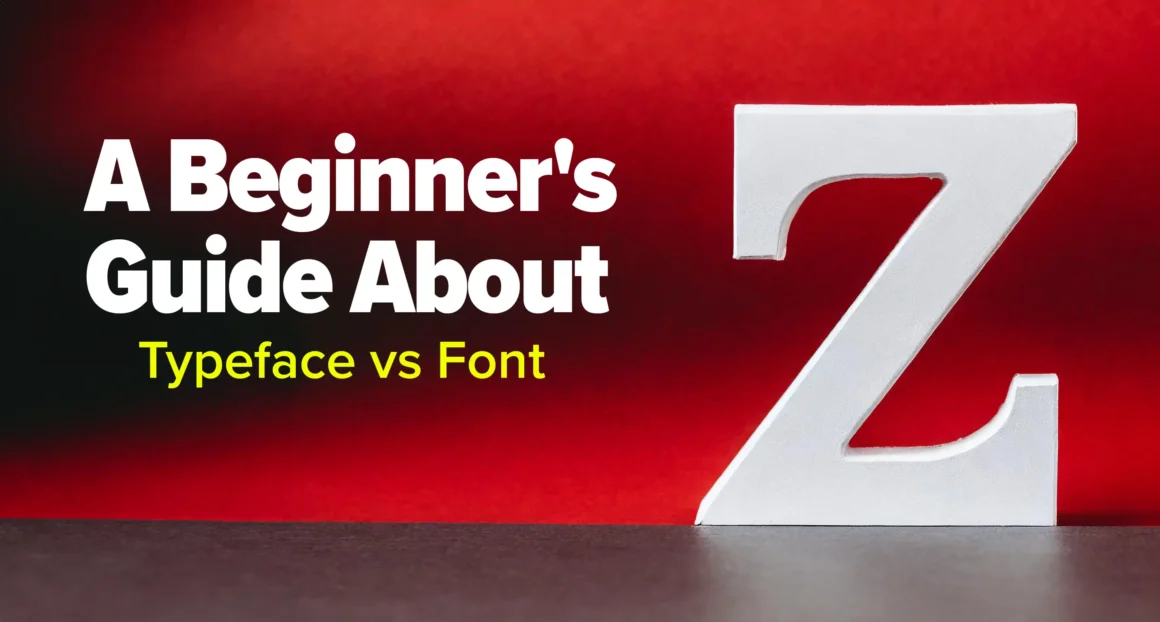In the world of computers and design, a typeface is like a writing style. It’s a set of letters, numbers, and symbols with a specific look and feel. Typefaces are used to make text look different and to convey a particular mood or message.
What is Typeface?

Some Words About History of Typeface
Typefaces have been around for a long time, even before computers. They started with the printing press, where each letter was a separate block. People would arrange these blocks to form words and sentences. With the advent of computers, typefaces became digital and easier to use.
Typeface vs Font – Clearing the Confusion
Some people use the words typeface and font interchangeably, but they are actually different. A typeface is the design of the letters, numbers, and symbols, while a font is the file that tells the computer how to display that design. Later in this article, I will compare them even more in-depth.
Here is an example for you to understand it easily:
Think of a typeface as the style of a car and the font as the blueprint that tells the car factory how to make that style.
Major Classification of Typefaces
There are several categories of typefaces, each with its own unique style:
- Serif typefaces have small lines at the ends of the letters, which can make them look more traditional and formal.
- Sans-serif typefaces don’t have these lines, giving them a more modern and cleaner look.
- Script typefaces mimic handwriting, adding a personal touch to the text.
- Display typefaces are bold and eye-catching, often used for headings and titles.
If you want to get more details about these Font Types, Visit Font Types and Their Perfect Uses in Your Business.
Popular Typefaces and Their Characteristics
Some typefaces have become famous for their unique styles and widespread use:
- Helvetica is a popular sans-serif typeface known for its clean and simple design, often used in modern designs.
- Times New Roman is a classic serif typeface that is easy to read, making it popular for printed materials.
- Arial is another sans-serif typeface similar to Helvetica but has a distinct look.
The Role of Typeface in the World of Design
Typefaces play a crucial role in design, as they can convey different emotions and messages. A bold and modern typeface might be used for a technology company’s logo, while an elegant and traditional typeface might be used for a wedding invitation. The choice of typeface can also affect how easy it is to read text, especially in long passages.
Latest Typeface Trends
Typeface trends change over time, often reflecting broader design trends. In recent years, there has been a trend towards more minimalistic and clean typefaces, reflecting a desire for simplicity and clarity in design.
However, there is also a trend toward more expressive and unique typefaces as designers seek to differentiate their work in a crowded market.
Evolution of Fonts
Fonts have come a long way from the days of metal types and printing presses. In the past, each typeface had to be physically created as a metal block. With the rise of computers, fonts became digital files that could be easily manipulated and used.
Digital Fonts: The Basics
A Digital Font is a file that contains all the information needed to display a typeface on a computer screen or in print. This file includes instructions for each character’s shape, size, and spacing in the typeface.
Digital fonts can be installed on a computer and used in various programs such as word processors and design software.
Practical Differences in Usage
In everyday use, the terms typeface and font are often used interchangeably. However, the distinction between the two is important in the world of design and typography. For example, you might choose a typeface for its style and design but then use different fonts within that typeface to create various effects, such as bold or italic text.
Common Misconceptions
- One common misconception is that typeface and font are the same thing.
- Another misconception is that changing the typeface or font of a document will change its meaning.
- In reality, the typeface or font you choose can affect how your message is perceived, but it won’t change the actual meaning of the words.
Important FAQs
What is the difference between a typeface and a font?
The typeface is the design of the letters, while a font is the digital file that contains that design.
Can you change the typeface in a document?
Yes, you can change the typeface or font of a document using word processing software.
How do you choose the right typeface for a project?
When choosing a typeface, consider the context of your project and the message you want to convey. Different typefaces can evoke different emotions and convey different meanings.
What are some popular typeface pairings?
Popular typeface pairings include pairing a serif typeface with a sans-serif typeface for contrast or using two complementary sans-serif typefaces for a modern look.
What are web-safe fonts?
Web-safe fonts are widely available on most computers and devices, ensuring your text will be displayed consistently across different platforms.














